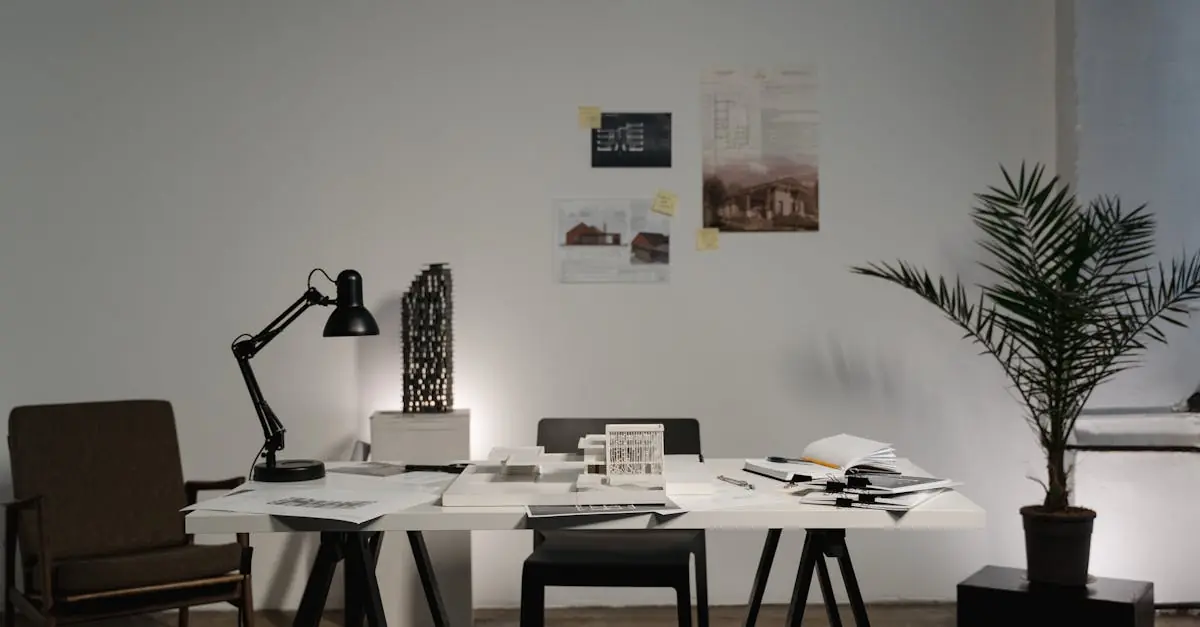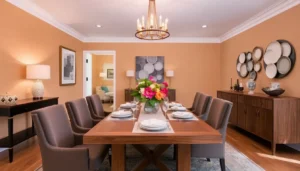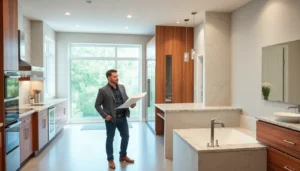The drawing room is more than just a space; it’s where the magic happens—or at least where the awkward small talk does. With the right interior design, this room can transform from a bland waiting area into a stylish sanctuary that reflects personality and flair. Imagine a space that invites guests in, encourages laughter, and maybe even sparks a deep philosophical debate about whether pineapple belongs on pizza.
From chic furniture arrangements to eye-catching decor, mastering drawing room design can elevate any home. With a little creativity and a dash of humor, anyone can create a welcoming atmosphere that balances comfort and sophistication. Let’s dive into the world of drawing room interior design and discover how to make this space not just livable, but truly unforgettable.
Table of Contents
ToggleOverview of Drawing Room Interior Design
Drawing room interior design focuses on creating a harmonious space that facilitates social interactions. This area often reflects personal style, showcasing furniture arrangements, colors, and decor elements that resonate with the homeowner’s preferences.
Effective layout designs prioritize functionality while ensuring comfort. Arranging seating to encourage conversation enhances the room’s welcoming nature. Placement of light fixtures influences its ambiance, making the space feel inviting during various times of the day.
Color palettes significantly impact the overall feel of the drawing room. Warm tones foster intimacy, while cooler shades can evoke calmness. Homeowners can mix and match hues to create visual interest and maintain cohesiveness throughout the design.
Incorporating textures adds depth to the drawing room. Combining materials such as wood, fabric, and metal introduces tactile variety, making the space more dynamic. Layering textiles through cushions and throw blankets contributes to the comfort level and visual appeal.
Accessories play a crucial role in personalizing the drawing room. Artwork, decorative mirrors, and plants enhance the overall aesthetic while reflecting the homeowner’s character. Selecting statement pieces can anchor the design and serve as conversation starters.
Overall, drawing room interior design integrates elements that create a functional yet stylish environment. Understanding the individual needs of its users leads to design choices that elevate the space, ensuring it meets both aesthetic and practical requirements. Adapting design principles to fit personal taste ensures the drawing room becomes a true reflection of the homeowner’s lifestyle.
Key Elements of Drawing Room Design
Key elements play a vital role in crafting an effective drawing room design. Each component contributes to the overall functionality and aesthetic.
Color Schemes
Color schemes significantly influence a drawing room’s ambiance. Warm tones such as reds or oranges create a cozy and inviting atmosphere. In contrast, cool shades like blues and greens promote tranquility and relaxation. The combination of different hues can enhance visual interest while maintaining harmony. Neutral palettes, including whites, beiges, or grays, serve as versatile backgrounds, allowing furniture and decor to stand out. Consider incorporating accent colors through accessories or artwork to add personality without overwhelming the space.
Furniture Selection
Furniture selection acts as the foundation of drawing room design. Comfortable seating options, like sofas and armchairs, invite conversation and relaxation. Prioritizing quality materials ensures durability while enhancing the room’s aesthetic. Multi-functional pieces, such as ottomans that provide extra seating or storage, maximize space efficiency. Selecting a cohesive style for furniture, whether modern, traditional, or eclectic, contributes to overall unity. Arranging furniture in a way that fosters interaction encourages social engagement and accessibility.
Lighting Options
Lighting options enhance the drawing room’s atmosphere. A combination of ambient, task, and accent lighting creates layered effects. Ceiling fixtures provide overall illumination, while table lamps and floor lamps offer focused lighting for reading or activities. Incorporating dimmer switches allows for adjustable brightness, accommodating different moods or occasions. Natural light should also be prioritized by utilizing curtains or blinds that let in sunlight. Thoughtfully placed lighting fixtures highlight artwork or architectural features, adding depth and inviting warmth to the space.
Popular Styles in Drawing Room Design
Various styles enhance drawing room design, each offering unique characteristics and atmospheres. These popular styles cater to diverse tastes and preferences.
Modern Minimalism
Modern minimalism emphasizes simplicity and functionality. This design style features clean lines and uncluttered spaces, inviting a sense of peace. Neutral color palettes dominate, with whites, grays, and blacks creating a serene backdrop. Furniture often serves multiple purposes, promoting practicality without sacrificing aesthetics. Accessories remain minimal, allowing for focal points that evoke interest without overwhelming the viewer.
Classic Elegance
Classic elegance portrays timeless beauty and refined sophistication. This style showcases rich colors like deep blues, burgundies, and warm golds, creating a luxurious atmosphere. Ornate furniture, often made from wood, enhances the sense of grandeur. Decorative elements include intricate moldings and plush upholstery, contributing to a feeling of opulence. Artwork and accessories maintain a curated appearance, with classical themes echoing throughout the space.
Eclectic Mix
Eclectic mix celebrates individuality and personal expression. This design style blends various elements, from vintage finds to contemporary pieces, creating an unequaled look. Bold colors often juxtapose, energizing the drawing room while adding warmth. Layered textures, including textiles and materials, add depth and visual interest. Each accessory and piece of furniture tells a story, making the room engaging and reflective of its occupants.
Tips for Creating a Functional Space
Creating a functional drawing room involves careful planning and thoughtful design decisions. Prioritize layout and accessorizing to ensure the space meets practical needs while reflecting personal style.
Layout Considerations
Assessing the room’s function plays a vital role in layout planning. Optimize seating arrangements to encourage conversation, placing sofas and chairs in a circular or L-shape. Consider flow; create clear pathways for easy movement around furniture. Avoid overcrowding by selecting appropriately sized pieces. Use focal points, like a fireplace or an artwork, to anchor the design and guide furniture placement. Layering rugs can add warmth while defining separate areas within the room. Adaptable furniture pieces enhance functionality, allowing for adjustments based on social needs.
Accessorizing Your Drawing Room
Enhancing the drawing room with accessories adds personality and charm. Select artwork that resonates with the homeowner’s aesthetic and place it strategically to create visual interest. Incorporate textured throws and cushions for added comfort, selecting colors that complement the overall palette. Include mirrors to reflect light and create an illusion of space. Adding greenery with houseplants brings life into the room while improving air quality. Statement pieces, such as unique vases or sculptural objects, foster conversation and showcase individual taste. Ultimately, accessories play a pivotal role in tailoring the drawing room to specific preferences and functions.
Creating a drawing room that embodies both style and comfort is essential for fostering social connections. By thoughtfully considering furniture arrangements color schemes and lighting options homeowners can craft a space that not only reflects their personal taste but also invites warmth and conversation.
Incorporating unique accessories and textures adds character while ensuring the room remains functional. Whether opting for modern minimalism classic elegance or an eclectic mix each design choice contributes to an environment that feels both welcoming and sophisticated.
Ultimately a well-designed drawing room serves as a true sanctuary for relaxation and connection enhancing the overall experience of home life.




